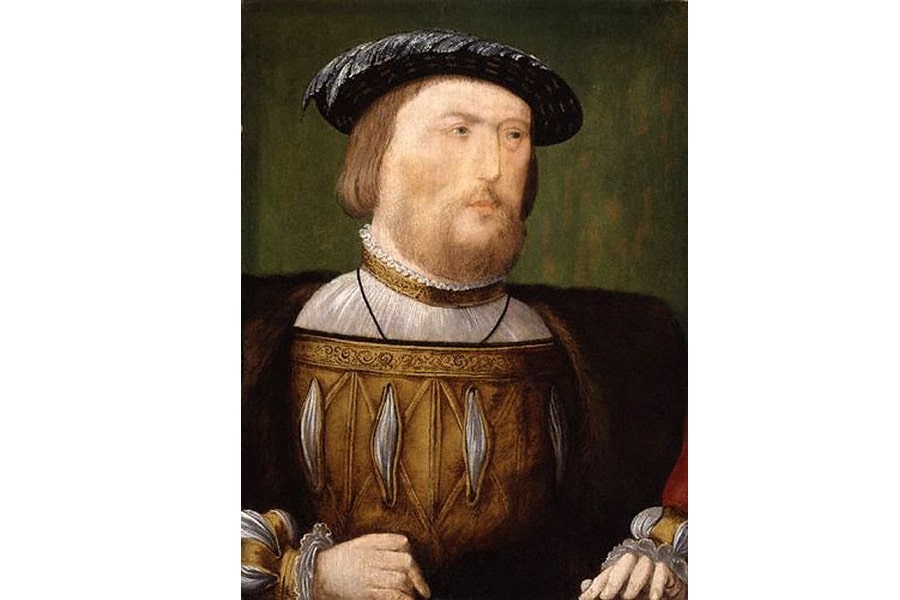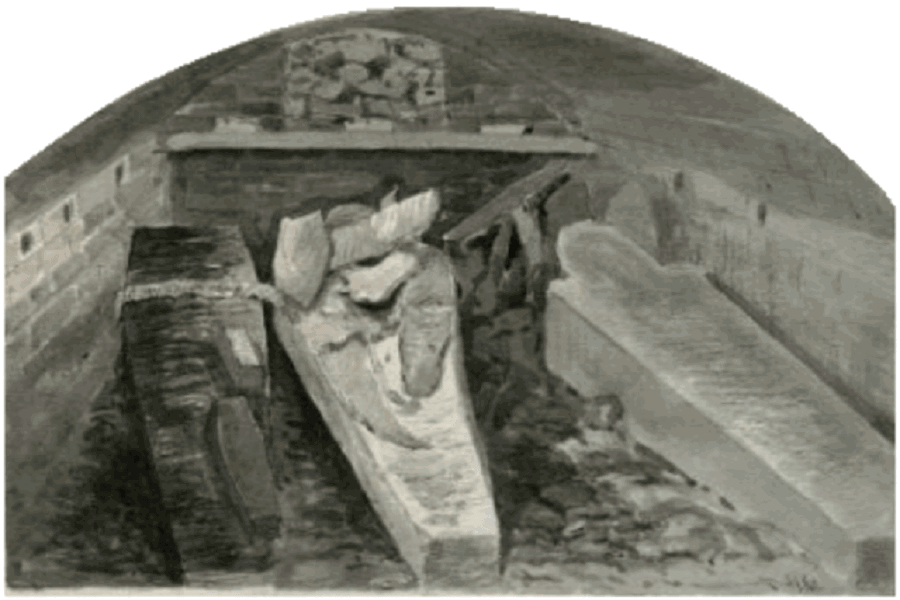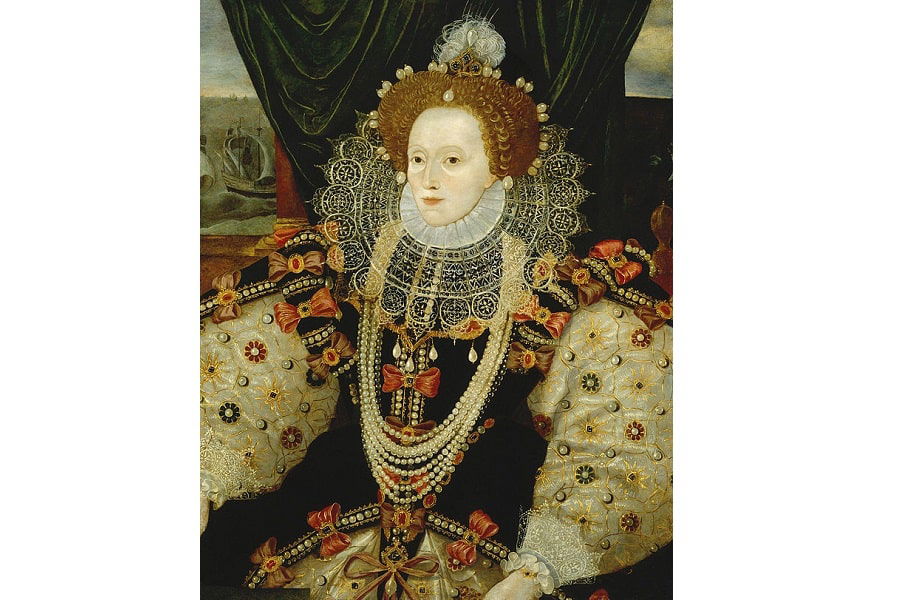Henry VIII, the King of England, died due to a combination of various health issues and complications. Although the exact details of his ailments and cause of death remain uncertain, historical accounts and medical records show that he might have died as a result of the injury he suffered. Because of this injury, his personality, weight, and overall health changed drastically, to a point of no return.
What were his last words? And what cocktail of diseases contributed to the eventual death of the king of England?
Table of Contents
When and How Did Henry VIII Die?

After an eventful life, Henry VIII died in the early hours of 28 January 1547. Henry VIII had an active and healthy life early on but saw a drastic change in lifestyle after an injury. While the exact cause of death has never been determined, doctors believed that his eventual obesity – caused by an inability to exercise – contributed to the death of the king. The obesity could’ve led to several strokes in his final hours.
While Henry’s medical history was documented in State Papers and the letters of the time, the actual cause of death was never determined properly. There are a ton of different suggestions for how Henry VIII died, but none really make a convincing or cohesive argument.
Most Acute Cause of Death: A Stroke
The most acute reason for his actual death might be a stroke. In the last couple of hours before his death, Henry suddenly wasn’t able to talk anymore. Not long after he lost his speaking abilities, he died. For this reason, some argue that multiple strokes in his final hours were the reason for his death.
Already in December, Henry was clearly ill and was advised to rest. Regardlessly, he carried on doing his state business. Because he assumed he wasn’t in any danger, he also didn’t think he would need a doctor to examine his condition. A pre-existing condition that might’ve caused the potential strokes at the end of his life was therefore never found.
Less Acute Causes of Death: Obesity and Varicose Ulcers

The reason for the strokes – if they actually happened to begin with – would certainly be related to his obesity. The last ten years of Henry’s life are the ones he is most known for and when he was suffering from severe obesity.
He ate and drank lavishly and excessively, which meant that towards the end, he could not walk or stand and had to be carried about in a sort of sedan chair. Excessive weight is dangerous and leads to heart failure, poor lung function, lack of mobility, and terminal bronchopneumonia – amongst others.
Back in the day, there was a lot less medical knowledge on these topics, simply because not a lot of people were obese. Because obesity is mostly a modern problem, doctors were unfamiliar with many of the side effects of the condition.
As Henry’s weight increased and he became morbidly obese, the risk of hypertension and Type II diabetes must also have been high. His doctors repeatedly exhorted him to reduce his tremendous consumption of meat and wine to improve his health.
Varicose Ulcers
Other than the side effects of obesity, Henry VIII’s body also had to deal with varicose ulcers. Either bad healing of a broken leg or severe venous hypertension may have been the underlying causes of this ulceration.
The ulcers didn’t disappear after they started to bother Henry, somewhere in 1536 or 1537. There are ample recordings of his swollen legs which had to be drained every so often to relieve Henry from the pressure. The veins could’ve become thrombosed, in turn adding to the health problems that were caused by the ulcers.
Obesity also might’ve had a role in the severity of his ulcers. Or rather, the potential Type II diabetes that came with it. Diabetes is known to accelerate peripheral vascular disease, which was basically what the ulcers were. In that sense, the combination of obesity and ulcers might’ve been the most prominent reason for Henry VIII’s rapid deterioration.
Some Other Hypotheses
There are really endless suggestions when it comes to the eventual cause of death for Henry. Gout is sometimes named because it ran in the family, while alcoholism is also an option due to his drinking habit. However, both of these seem unlikely.
READ MORE: The Birth of Booze: Who Invented Alcohol and How It Shaped History?
Syphilis
The first hypothesis is syphilis, which is maybe the most popular alternative second to his obesity-related problems. The illness came from the Americas in the late 15th century and early 16th century. The symptoms of the disease include acute ulceration, the growth of gummas, loss of balance, and eventually something called general paralysis of the insane.
As indicated before, Henry did suffer from ulcers on his leg and may possibly have had gumma or some other sort of inflammation. However, he never suffered from general paralysis of the insane.
To add, his medicinal records don’t indicate that he received mercury; something that was given to treat syphilis. The death of Henry VIII is therefore not likely caused by syphilis.
General Malaise and Lack of Rest

Henry suffered from many different injuries. He was a heavy breather, had a series of head injuries including concussions, and also had to deal with a series of internal injuries. However, he never properly took the rest to recover from these illnesses and injuries. This potentially could’ve transformed some temporary injuries into chronic ones.
There is a hypothesis that Henry had a combination of inflammation, chronic pyogenic suppuration (a bone infection), edema, and chronic osteomyelitis (another bone infection but in a different part).
To add, some hypotheses even add a chronic inflammation of the kidneys. Everything together is simply too much for a human body, even if that body belongs to the king of England.
How Old Was Henry VIII When He Died?

Henry VIII was 55 years old when he died in 1547. His body rests in a vault that is located under the Quire in St George’s Chapel at Windsor Castle, close to his third wife Jane Seymour.
The sarcophagus that was intended to form part of Henry’s final resting place was never used, however, and it was given to one of his contemporaries who was buried in the St Paul’s Cathedral.
The fact that he wasn’t placed in the sarcophagus that was specially made for him might have to do with the state of his body. Legend has it that Henry’s body at the end was insanely bloated, so it’s not odd to imagine that the already obese king wouldn’t fit the coffin that was made for him.
What Were Henry VIII Last Words?
‘I will first take a little sleep, and then, as I feel myself, I will advise upon the matter’. Those were the last words of Henry VIII. Clearly, he wasn’t planning on dying anytime soon, since it was a response to whether he desired a minister of God to hear his latest confession. Henry did indeed go to sleep and woke up the next morning, but lost his ability to speak. Not long after, Henry died in Whitehall Palace in London.
After his death, Prince Edward VI and Princess Elizabeth were informed about the death of their father, which they didn’t take very well. Although they were the first heirs to Henry VIII, they were just at the age of 9 and 16. So it’s safe to say they were rather fearful for their future.
The Funeral of Henry VIII

Henry VIII was buried on 16 February 1547, twenty days after his death. During the week preceding the funeral, his body was moved from the palace where he died to the place where the funeral took place; St George Chapel in one of the historic royal palaces.
It took some time before the actual death of the king was announced. For ten days, the embalmed body of the king lay in the privy chamber. Eventually, his death was announced on the 8th of February. The churches throughout the kingdom rang their bells and said their Requiem masses for the king’s soul.
On the 14th of February, about 1000 horsemen and many followers gathered around a gigantic hearse made for the king. Today, we would use a long black car to transport the coffin to the funeral. In the 16th century, however, there were no cars as of yet, so a chariot was used.
The chariot used for Henry’s coffin had many wheels and was covered with black velvet – as well as a myriad of different heraldic banners – and was pulled by eight horses ridden by children.
The hearse itself was actually seven stories high, and the road had to be repaved in order to bear the weight of the hearse. On top of his coffin was his effigy; a life-size statue of the late king. It was carved from wood and wax, and decorated with expensive robes and the Imperial Crown.
Because it was so high, they cut the trees on the side of the road to let the chariot pass through. Everything together must’ve been insanely heavy, not for the least because the lead used to encase the embalmed corpse of the king weighed over half a ton.
Henry had plans for creating a grand tomb for himself in which he could rest. He was still in the process of constructing it when death came around the corner. None of his children ever bothered to finish his project, meaning that Henry remained in an unmarked grave for a long time.
What Happened to Henry VIII?
While once an athletic figure, King Henry VIII eventually became obese because he lost his ability to exercise. Two incidents are at the roots of his inability to exercise; most notably an incident in 1536 where a horse fell on him – changing his character forever. He also saw his health rapidly decline as a result of his inactivity, which eventually led to his early death.
As a young prince, Henry VIII was cultured and supremely athletic. He lived in Greenwich, where he could perform his martial sports. He was an excellent jouster, which is a medieval game where two combatants fought each other on horse or foot. Greenwich Park was basically his playground. Here, he built ample stables, kennels, tennis courts, and farms.
READ MORE: Who Invented Tennis? Exploring the History Behind the Game’s Creation

The Injury of Henry VIII
In 1516, he built a tiltyard tournament ground, where the games of jousts took place. In 1536, however, it was this very place that would change him forever following a jousting accident.
King Henry VIII was in his 40s and just finished a game. Fully dressed in armor, Henry came off his horse. But, one way or another, he imbalanced his horse while he was stepping off. The horse, which was also fully armored which was required for the medieval sport, fell right on him.
Henry was knocked unconscious for two full hours. Many of the people in his inner circle thought the king would never recover fully from the incident, and eventually die of complications. However, he did recover. Many thought, however, that this wasn’t necessarily a good thing.
The two hours of unconsciousness had a severe impact on Henry. Legend has it that he woke up with a drastically different personality. As you might know, King Henry VIII is mostly known as a bullying tyrant, which is directly linked to his personality change after the incident.
The change in personality was caused by severe head trauma. While he used to be an enjoyable man after the accident he became more agitated and actually somewhat of a bullying tyrant. This incident also marked the end of his sporting life because Henry was never able to joust again. Simultaneously, he wasn’t able to go on six-hour hunts or play his beloved tennis.
His appetite didn’t change, however, which meant that the court servant had to order new clothes every couple of months just to keep up with his expanding belly. At the time of his death, the king weighed about 25 stones (about 160 kilograms or 350 pounds).
Outside of head trauma, Henry also suffered from a severe leg injury. This would eventually lead to open ulcers that bothered him for the rest of his life. The ulcers threatened his life more than once, but eventually, Henry’s reign came to an end due to different reasons.
The Will of Henry VIII
During the last week of December 1546, Henry VIII used his will to make a political step that shows his hopes for living a long life and continuous rule. The will was signed using a ‘dry stamp’ under the control of two courtiers from his privy council by the name of Sir Anthony Denny and Sir John Gates.
Since his will was made up just a month before his death, it is often seen as a document that enabled him to rule from his grave. However, his will could also be interpreted as a way to control the new generation in court.
Content of the Will
The will confirmed the line of succession with one living male and six living females. Henry agreed in his will that the first successor was the young Prince Edward VI, his son. Afterwards, his daughters Elizabeth and Mary had a claim to the throne.

READ MORE: Queen Elizabeth Regina: The First, The Great, the Only
Three daughters from Frances Gray – the eldest daughter of Henry’s sister Mary – followed his own children: Jane, Katherine, and Mary. Lastly, the youngest daughter of Eleanor Clifford – the youngest daughter of the king’s sister – awaited her chance. She went by the name of Margaret.
Council of Sixteen
The will also picked 16 executors that were in charge of the successors right after Henry’s death. The idea was that there had to be a majority vote about anything regarding the decisions that the upcoming king or queen should make.
As for his son, at the time of writing the latest version of the will, he was just nine years old, meaning that he needed a guardian in case of the passing of the king. However, Henry saw this as appointing his successor and feared an unwanted transfer of power to a different family. So, he opted not to appoint more than one guardian.
He opted for a council of 16 co-equals that had to take care of his successor Edward VI. Only through a majority vote, decisions were made legitimate.
The idea of Henry VIII was to use the will as a tool to influence people. The council of sixteen was indeed the one that had a shot at absolute power after Henry’s death. The king knew this and actually wrote some very close people out of his will.
By doing so, Henry showed that he, at any time, had the power to determine the fate of the ones in the council.
Unfortunately for Henry, the desires that he expressed in his will were simply ignored. Not a council of equals managed the regency of Edward, but rather Lord Hertford by himself. He was made Lord Protector, which is essentially the one who fulfills the role of the king.